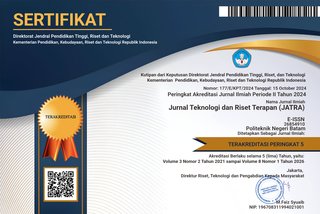Pemetaan Sebaran Titik Panas (Hotspot) Tahun 2017-2021 Di Kota Batam
DOI:
https://doi.org/10.30871/jatra.v4i2.4665Keywords:
Hotspots, Batam City, MODIS, Gridding, FireAbstract
The city of Batam has a bush area that is quite extensive so that this can trigger forest and land fires in the city of Batam. The city of Batam has quite hot weather so that it is one of the factors that cause forest fires. The purpose of this study is to determine the distribution of the value or number of hotspots in 2017-2021 in Batam City and to determine the distribution of hotspots to land cover in 2017-2021 in Batam City. This study uses several data, namely MODIS image hotspot data sourced from the National Aeronautics and Space Institute (LAPAN) for 2017-2021, a map of land cover distribution and an administrative map of Batam City. The initial data processing process in this research is to convert MODIS image hotspot data obtained from the National Institute of Aeronautics and Space (LAPAN) with .csv format into .shp format for further overlaying with a land cover map, after that perform a gridding process that aims to to get the distribution of values or the number of hotspots. From the results of MODIS image hotspot data sourced from the National Institute of Aeronautics and Space (LAPAN) during 2017-2021 there are 119 hotspots located in 22 clusters in an area of 1km x 1km and during 2017-2021 it is known that the number of hotspots (hotspots) in the scrub area there are 8 hotspots in forest areas there are 6 hotspots and in non-forest areas there are 105 hotspots.
Downloads
References
Adinugroho, W.C (2005). Kebakaran Hutan dan Lahan. Wetlands International-Indonesia Progamme
, 1-2.
Wibowo, A. 2003. Permasalahan dan pengendalian kebakaran hutan di Indonesia. Review Hasil Litbang. Pusat Litbang Hutan dan Konservasi Alam.
Bogor
Giglio, Luis, Decroitre, J (2003) "Peningkatan algoritma deteksi kebakaran kontekstual untuk MODIS". Jurnal Penginderaan Jauh Lingkungan, 87, 273-282.
Yonathan, D. 2006. Investigasi sebaran hotspot sebagai indikator kebakaran hutan dan lahan di Provinsi Jambi dari tahun 2000 hingga 2004 [makalah].Bogor (ID): Balai Penelitian Pertanian Bogor
Hartono, B. 1988. Kebakaran Hutan. Direktorat Jenderal Perlindungan Hutan dan Pelestarian Alam. Bogor.
Endrawati. (2016). Analisis data titik api dan kawasan kebakaran hutan, 1-2. Direktorat Jenderal Perencanaan Hutan.
Berry, W. Michael, Malu Castellanos, Survey of Text Clustering, 2008, Springer-Verlag London Limited
[KLHK] Kementerian Lingkungan Hidup & Kehutanan Republik Indonesia. 2016.
Rama, Arkansas (2018). Analisis akurasi perhitungan volume tanah galian dengan dan tanpa data gridding 3-4.
Roziqin, A. 2016. Pemodelan GIS untuk kesesuaian permukiman di wilayah pesisir Nongsa Batam. Seminar Nasional Teknologi Terapan (SNTT), Yogyakarta.
Budiyanto, E. 2002. Sistem Informasi Geografis Menggunakan ArcView GIS.
Eriko, U. (2013). Modul Pelatihan ArcGIS 10.1, diproduksi oleh Comlabs USDI ITB.
Baker, Ryan S.J.d. 2009. AReview and Future VisionsData Mining for Education, Journal of Educational Data Mining, October 2009, Volume 1, Issue 1.
Rani, F. 2015. Kebijakan Pemerintah Indonesia dalam Mengatasi Hambatan Free Trade Zone di Batam (Studi Kasus : Hutan Lindung)
Syaufina L. 2008. Kebakaran hutan dan lahan di Indonesia: Perlaku api, penyebab & efek kebakaran. Malang (ID) : Penerbitan Bayu Media
Additional Files
Published
How to Cite
Issue
Section
License
Copyright (c) 2022 Jurnal Teknologi dan Riset Terapan (JATRA)

This work is licensed under a Creative Commons Attribution-NonCommercial-ShareAlike 4.0 International License.




11.jpg)











